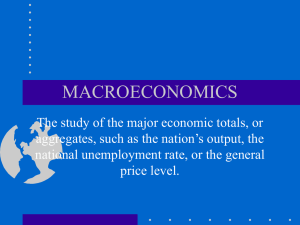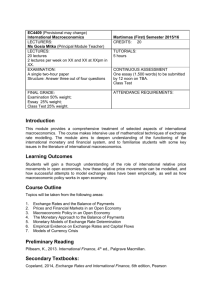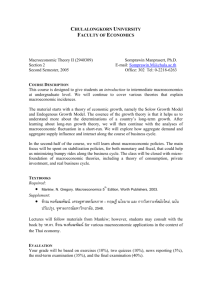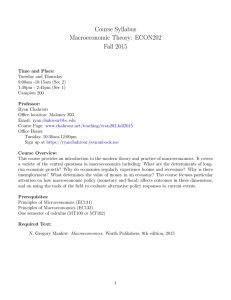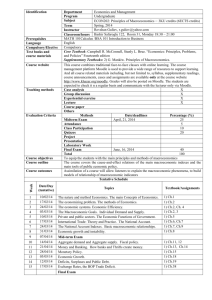Some Thoughts on the State of Macro
advertisement
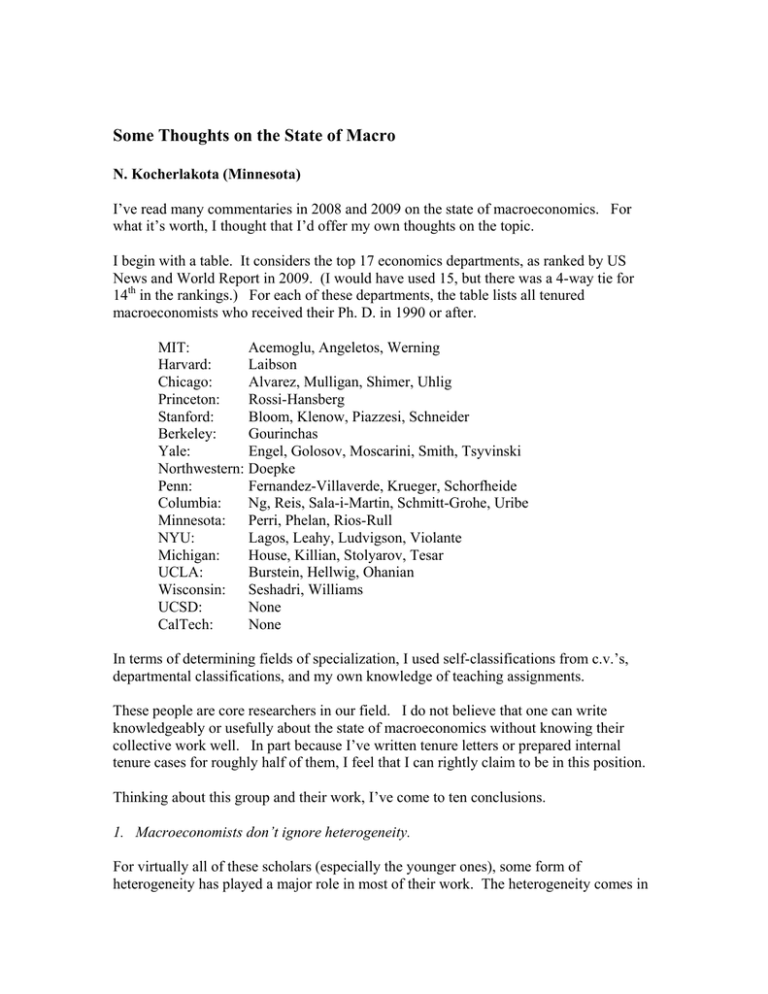
Some Thoughts on the State of Macro N. Kocherlakota (Minnesota) I’ve read many commentaries in 2008 and 2009 on the state of macroeconomics. For what it’s worth, I thought that I’d offer my own thoughts on the topic. I begin with a table. It considers the top 17 economics departments, as ranked by US News and World Report in 2009. (I would have used 15, but there was a 4-way tie for 14th in the rankings.) For each of these departments, the table lists all tenured macroeconomists who received their Ph. D. in 1990 or after. MIT: Acemoglu, Angeletos, Werning Harvard: Laibson Chicago: Alvarez, Mulligan, Shimer, Uhlig Princeton: Rossi-Hansberg Stanford: Bloom, Klenow, Piazzesi, Schneider Berkeley: Gourinchas Yale: Engel, Golosov, Moscarini, Smith, Tsyvinski Northwestern: Doepke Penn: Fernandez-Villaverde, Krueger, Schorfheide Columbia: Ng, Reis, Sala-i-Martin, Schmitt-Grohe, Uribe Minnesota: Perri, Phelan, Rios-Rull NYU: Lagos, Leahy, Ludvigson, Violante Michigan: House, Killian, Stolyarov, Tesar UCLA: Burstein, Hellwig, Ohanian Wisconsin: Seshadri, Williams UCSD: None CalTech: None In terms of determining fields of specialization, I used self-classifications from c.v.’s, departmental classifications, and my own knowledge of teaching assignments. These people are core researchers in our field. I do not believe that one can write knowledgeably or usefully about the state of macroeconomics without knowing their collective work well. In part because I’ve written tenure letters or prepared internal tenure cases for roughly half of them, I feel that I can rightly claim to be in this position. Thinking about this group and their work, I’ve come to ten conclusions. 1. Macroeconomists don’t ignore heterogeneity. For virtually all of these scholars (especially the younger ones), some form of heterogeneity has played a major role in most of their work. The heterogeneity comes in different forms. It may be heterogeneity in terms of income or wage realizations. It may be heterogeneity in terms of job arrivals. It may be heterogeneity in terms of sex or age. It may be heterogeneity in terms of information about the macro-economy. It may be heterogeneity in firm productivity. And so on and so on … 2. Macroeconomists don’t ignore frictions. Point 1 pretty much implies point 2, because heterogeneity is typically not all that interesting without frictions. So, again, for most of these scholars, frictions of some kind lie at the heart of most of their work. Of course, much of the work on monetary economics has some kind of price rigidity. Some papers have labor market frictions, so that workers take time to find jobs. Many papers have asset market frictions. In this work, agents or firms face borrowing constraints of some kind and cannot fully insure themselves against individual-specific shocks (so-called incomplete markets models). Many papers use overlapping generations models (with realistic multiperiod lifetimes) and assume that parents cannot borrow from their children. Frictions are all over the place in modern macroeconomics. 3. Macroeconomic modeling doesn’t ignore bounded rationality. A lot of macroeconomic modeling does treat all agents as fully rational. But a lot does not – see work by Angeletos, Laibson, Piazzesi, Reis, Schneider, Werning, and Williams (probably among others). These people work at some of the top departments in the country – they are hardly shunned as heterodox pariahs. 4. Macroeconomic models do incorporate a role for government interventions. Once you start using macroeconomic models with heterogeneous agents and frictions, government intervention is almost inevitable. The Minnesota and Chicago Ph. D.’s are probably best known for being anti-government. Yet, to pick three of the people on the list, Golosov (Minnesota), Tsyvinski (Minnesota), and Werning (Chicago) have been studying government insurance/taxation systems for most of their careers. 5. Macroeconomists use both calibration and econometrics. Some macroeconomists use calibration, some use econometrics, and some use both. There’s no real methodological debate left in the field on this issue. What is true is that most people outside of macro do not like calibration. I don’t know why. I spent seven years of my life thinking about whether econometrics was better than calibration … and pretty much decided that the answer is: “it depends”. 6. There is no freshwater/saltwater divide – now. These scholars work on different questions and use different models. But it’s hard to see obvious ways to slice them into freshwater/saltwater camps. Nonetheless, the list does reveal the imprint of an old freshwater/saltwater conflict, largely won by the freshwater school. First, compared to other fields in economics, there are surprisingly many Minnesota and Penn Ph. D.’s on this list, and surprisingly few Harvard Ph. D.’s. Second, some departments have shockingly few young tenured scholars in this important field (including large departments like Harvard and Princeton). 7. These researchers have been much more interested in the consequences of shocks than in their sources. Why do we have business cycles? Why do asset prices move around so much? At this stage, macroeconomics has little to offer by way of answer to these questions. The difficulty in macroeconomics is that virtually every variable is endogenous – but the macro-economy has to be hit by some kind of exogenously specified shocks if the endogenous variables are to move. The sources of disturbances in macroeconomic models are (to my taste) patently unrealistic. Perhaps most famously, most models in macroeconomics rely on some form of large quarterly movements in the technological frontier. Some have collective shocks to the marginal utility of leisure. Other models have large quarterly shocks to the depreciation rate in the capital stock (in order to generate high asset price volatilities). None of these disturbances seem compelling, to put it mildly. Macroeconomists use them only as convenient short-cuts to generate the requisite levels of volatility in endogenous variables. This particular group of younger scholars has worked more on the consequences of these disturbances and less on uncovering their true sources. I suspect that this ranking of priorities can be attributed in part to the Great Moderation of 1982-2007. Recent events may well lead to a shift in research priorities. 8. The modeling of financial markets and banks in macroeconomic models is stark. It is not true that all macroeconomic models assume complete financial markets – quite the contrary (see point 2 above). However, few macroeconomic models capture an intermediate messy reality in which markets are incomplete but there are nonetheless many assets and/or asset trade is conducted through intermediaries. As a consequence, we don’t understand the sources (or costs/benefits) of large-scale daily (or even quarterly) financial asset re-allocation. In part, this omission reflects a belief among macroeconomists that this level of institutional detail was not essential for questions of interest. In part, it reflects the extreme difficulty in handling mathematical formalizations of these features of reality (see point 9 below). Again, recent events may well lead to a re-ordering of priorities. 9. Macroeconomics is mostly math and little talk. The work of the people on this list is pretty technical. Most are very gifted intuitive economists. But intuition necessarily plays a limited role in macroeconomics. There are just too many things going on in a macroeconomic model of any interest to rely on intuition alone. Intuitive explanations invariably end up focusing on one or two of the many equations in a macro model (let alone the many more that operate in the world). The other equations might well end up undoing an effect that seems perfectly reasonable from just looking at one equation in isolation. I believe that it is our need to formalize ideas and intuitions in mathematics that leads to a key misperception about macroeconomics, even among other economists. Macroeconomic models leave out many possibly important features of the real world. Sometimes, we choose to do so. Far more often, we leave out these aspects of reality because we must: given our computational and conceptual limitations, we simply cannot handle these things in our mathematical models. The good news is that, thanks in part to the people on this list, we’ve made enormous progress in the kind of realistic complications that we can usefully model. Of course, there is always more left to be done – and recent events have certainly pointed out useful directions for future work. 10. The macro-principles textbooks don’t represent our field well. Little of the exciting work that’s been done by this group has made its way into undergrad textbooks. That’s probably inevitable. But it leads to a real misunderstanding about what macroeconomists do – both among lay-people and among economists in other fields. I hope that some of our gifted textbook writers rectify that situation soon!
